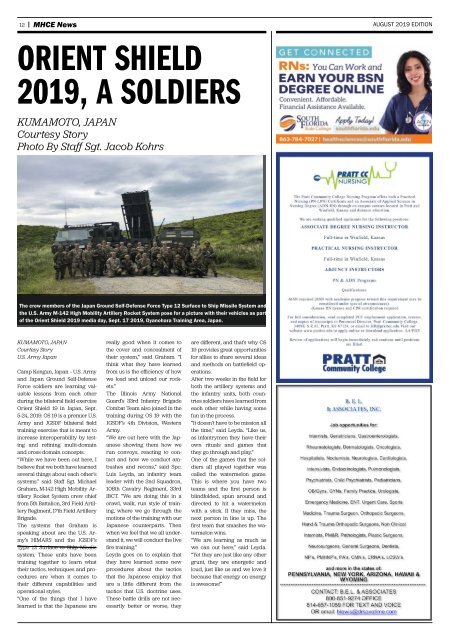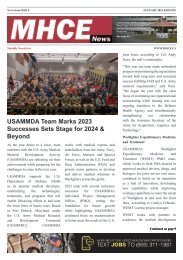MHCE September 2019 Publication
MHCE September 2019 Publication
MHCE September 2019 Publication
You also want an ePaper? Increase the reach of your titles
YUMPU automatically turns print PDFs into web optimized ePapers that Google loves.
12<br />
<strong>MHCE</strong> News<br />
AUGUST <strong>2019</strong> EDITION<br />
ORIENT SHIELD<br />
<strong>2019</strong>, A SOLDIERS<br />
KUMAMOTO, JAPAN<br />
Courtesy Story<br />
Photo By Staff Sgt. Jacob Kohrs<br />
The crew members of the Japan Ground Self-Defense Force Type 12 Surface to Ship Missile System and<br />
the U.S. Army M-142 High Mobility Artillery Rocket System pose for a picture with their vehicles as part<br />
of the Orient Shield <strong>2019</strong> media day, Sept. 17 <strong>2019</strong>, Oyanohara Training Area, Japan.<br />
KUMAMOTO, JAPAN<br />
Courtesy Story<br />
U.S. Army Japan<br />
Camp Kengun, Japan – U.S. Army<br />
and Japan Ground Self-Defense<br />
Force soldiers are learning valuable<br />
lessons from each other<br />
during the bilateral field exercise<br />
Orient Shield 19 in Japan, Sept.<br />
5-24, <strong>2019</strong>. OS 19 is a premier U.S.<br />
Army and JGSDF bilateral field<br />
training exercise that is meant to<br />
increase interoperability by testing<br />
and refining multi-domain<br />
and cross-domain concepts.<br />
“While we have been out here, I<br />
believe that we both have learned<br />
several things about each other’s<br />
systems.” said Staff Sgt. Michael<br />
Graham, M-142 High Mobility Artillery<br />
Rocket System crew chief<br />
from 5th Battalion, 3rd Field Artillery<br />
Regiment, 17th Field Artillery<br />
Brigade.<br />
The systems that Graham is<br />
speaking about are the U.S. Army’s<br />
HIMARS and the JGSDF’s<br />
Type 12 Surface to Ship Missile<br />
system. These units have been<br />
training together to learn what<br />
their tactics, techniques and procedures<br />
are when it comes to<br />
their different capabilities and<br />
operational styles.<br />
“One of the things that I have<br />
learned is that the Japanese are<br />
really good when it comes to<br />
the cover and concealment of<br />
their system,” said Graham. “I<br />
think what they have learned<br />
from us is the efficiency of how<br />
we load and unload our rockets.”<br />
The Illinois Army National<br />
Guard’s 33rd Infantry Brigade<br />
Combat Team also joined in the<br />
training during OS 19 with the<br />
JGSDF’s 4th Division, Western<br />
Army.<br />
“We are out here with the Japanese<br />
showing them how we<br />
run convoys, reacting to contact<br />
and how we conduct ambushes<br />
and recons,” said Spc.<br />
Luis Leyda, an infantry team<br />
leader with the 2nd Squadron,<br />
106th Cavalry Regiment, 33rd<br />
IBCT. “We are doing this in a<br />
crawl, walk, run style of training,<br />
where we go through the<br />
motions of the training with our<br />
Japanese counterparts. Then<br />
when we feel that we all understand<br />
it, we will conduct the live<br />
fire training.”<br />
Leyda goes on to explain that<br />
they have learned some new<br />
procedures about the tactics<br />
that the Japanese employ that<br />
are a little different from the<br />
tactics that U.S. doctrine uses.<br />
These battle drills are not necessarily<br />
better or worse, they<br />
are different, and that’s why OS<br />
19 provides great opportunities<br />
for allies to share several ideas<br />
and methods on battlefield operations.<br />
After two weeks in the field for<br />
both the artillery systems and<br />
the infantry units, both countries<br />
soldiers have learned from<br />
each other while having some<br />
fun in the process.<br />
“It doesn’t have to be mission all<br />
the time,” said Leyda. “Like us,<br />
as infantrymen they have their<br />
own rituals and games that<br />
they go through and play.”<br />
One of the games that the soldiers<br />
all played together was<br />
called the watermelon game.<br />
This is where you have two<br />
teams and the first person is<br />
blindfolded, spun around and<br />
directed to hit a watermelon<br />
with a stick. If they miss, the<br />
next person in line is up. The<br />
first team that smashes the watermelon<br />
wins.<br />
“We are learning as much as<br />
we can out here,” said Leyda.<br />
“Yet they are just like any other<br />
grunt, they are energetic and<br />
loud, just like us and we love it<br />
because that energy on energy<br />
is awesome!”


















